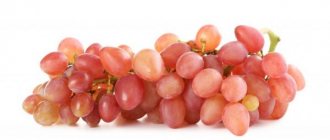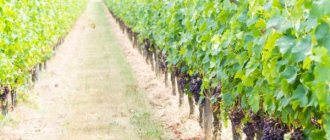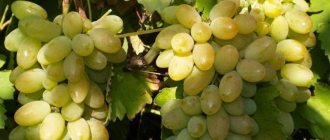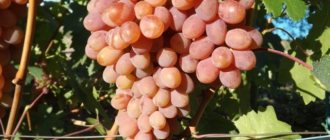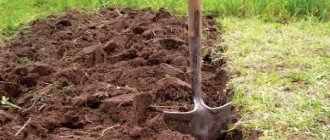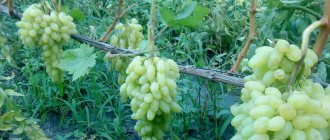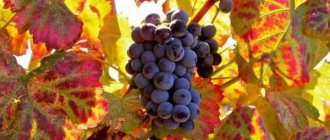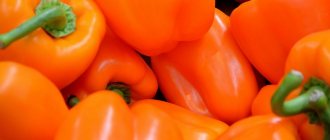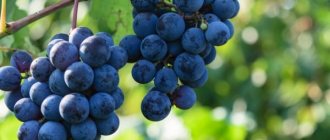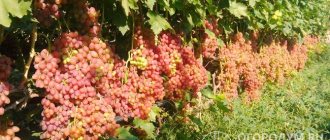Once upon a time, grapes were considered to be an exclusively southern plant. They tried to grow the crop in regions with a harsh climate, but in the cold season the vine partially or completely froze, despite the fact that it was covered for the winter. But over time, forms of grapes emerged that were tolerant of low temperatures and showed high yields. Currently, the crop is successfully grown in the Siberian regions. Today we have prepared a review of Northern grapes, which are frost-resistant species.
From the history
There is no exact information about the origin of this variety. There are several versions. The most common one says: the creator was the famous breeder I.V. Michurin. In fact, Ivan Vladimirovich did a lot to promote grapes to the northern regions, but among the Michurin varieties there is no name for the Northern Sweet grape. When researching its origin, information was found that in 1936, breeders Ya.I. worked on breeding frost-resistant species. Potapenko in collaboration with E.I. Zakharova, they managed to develop Northern grapes by crossing the Amur variety with the Michurin Seedling Malengra. Later, the word “sweet” was added to the name of the variety.
Origin of the variety
No one really knows who created this variety. Information about the author and parent vines has been lost. Worked in this direction I.V. Michurin. He set himself the following goal: to create a truly frost-resistant variety. Minus 30 is, of course, not frost, it can be even stronger, however, for grapes this is a really good indicator.
However, in Michurin’s works there is no mention that he grew the Northern Sweet variety. People know him well and under that name. Judging by external signs, Northern Sweet had a vine of the famous Pinot in his family. However, no one can say for sure whether this is actually true. Perhaps laboratory research will help find answers and figure out what kind of variety this is.
The Northern Sweet grape variety is popular. Wine made from it has a pleasant, complex taste. Perhaps this is a worthy competitor to Pinot. But he is still far from world fame and worldwide recognition; everything is ahead. I would like to know who created it. The sugariness and sourness are as impressive as the frost resistance. If this is an example of amateur selection, only word of mouth will help establish the authorship. If this is the result of the work of specialists, breeding scientists, geneticists, the authorship will be helped to establish the analysis of documents.
Description
Northern is a winter-hardy grape variety. The shoots of this plant are famous for their great growth vigor. The vine is characterized by such quality as good ripening, which contributes to high frost resistance. The grapes tolerate low temperatures quite steadfastly (down to minus 30 ° C). Northern Sweet is a technical variety with a medium ripening period.
About 135 days pass from the moment the buds open to the start of the harvest. In the south of our country, grapes begin to be harvested from the end of August to the first ten days of September. In the Moscow region and more northern regions, the harvest ripens on the twentieth of the first autumn month.
Northern Saperavi characteristics
Saperavi itself is a very old variety that is suitable for red and dessert wines. The main feature of Saperavi is that it can produce different tastes depending on its growth environment. That is, in different territorial regions, the taste of saperavi will differ from each other. It is this variety that has always been considered southern. Saperavi grapes love moist soil with a minimum amount of lime. Planting this is in demand among grape lovers. Like the “northern”, Saperavi, vigorous. The varieties are even externally similar to each other. And the following characteristics may seem typical:
- The weight of the bunch is up to 120 grams.
- Sugar content approximately 25%.
- Gives a big harvest.
- Belongs to late varieties.
Externally, the first difference from the northern sweet is only the shape of the berries. In Saperavi, it is more oval. The leaves of the bush have rounded features and are light green in color. The berries are covered with a slightly white coating. The vine ripens well. Flowers have both sexes, so no additional pollination is required.
Wine from this variety is highly valued throughout the world. The founders of Saperavi winemaking are the Georgians. Winemakers have noticed that wine made from this variety improves its taste with age. This is highly valued in winemaking and is an indicator of quality grapes.
It was by crossing this famous variety and the northern sweet that Russian breeders, back in 1947, obtained the northern saperavi. A unique frost-resistant grape variety that has the taste and wine-making qualities of Saperavi, the planting of which was a success the first time. These varieties, together, are capable of winning the hearts of all lovers of both wine and just grapes. Its use in the northern regions makes it possible to obtain various high-quality products due to its productivity.
Saperavi grapes love moist soil with a minimum amount of lime
Characteristics of bunches and berries
The grape clusters are small (their weight reaches no more than 80-120 g), conical in shape, moderately dense. The shape of the berries is round, classic, each weighs on average 1.5-2 g. On one bunch you can simultaneously find both large and small berries. The color can be dark blue or blue-violet with a slight waxy coating on the skin.
Northern grapes have excellent characteristics: the pulp is juicy, with a sweet and sour harmonious taste, the sugar content is high - its value is 19-25%, acidity ranges from 6 to 11 g/mol. The indicators depend on what time the bunches were removed from the vine. It is believed that the longer the crop is not harvested, the more sugars and acids accumulate in it.
The skin of the berries is strong, dense, but quite thin. They have high transportability and keeping quality. The advantage of such a thick skin is that bees, wasps and birds cannot damage it, and therefore there is no need to protect the crop from them. The skin of grapes is easily separated from the pulp, and the berries themselves have high taste. Advantages of Northern grapes:
- productivity;
- good ripening of shoots;
- frost resistance;
- it is resistant to oidium and other diseases.
Among the disadvantages, it can be noted that with a lack of water, not only the taste deteriorates, but also the yield decreases. Despite the fact that Severny is declared as a frost-resistant variety that can tolerate low temperatures, it is recommended to grow the crop under light shelter in the conditions of the Urals, Siberia and northern regions. Also, before winter, you can lay the vine on the ground, in which case the grapes will be securely covered with fallen snow.
The variety is high-yielding. It can be used to prepare high-quality homemade wine that will have a rich, pleasant taste. In most regions of our country, summer is short and cool, with few sunny days. Winter here is usually frosty and long. In order to obtain high yields, you need to know and follow some subtleties of agricultural technology.
Foliage Features
The leaf blade often has faint lateral notches, less often they are noticeable and form a pattern. The leaf is dense, dissected with veins. The lateral teeth may also be noticeable, or they may be practically absent. Despite the changeability of shape, a description of the variety without indicating the characteristics of the foliage will be incomplete. Grapes are often grown to decorate a plot - they are a very attractive plant. Its natural features make decoration simpler and landscape design more interesting.
Northern Sweet is often grown to decorate a plot
What you can expect from Northern Sweet is that, with proper care, your gazebo or shed will turn out great. It is easy to zoning an area with its help - the leaves are expressive, dense, and medium in size.
Features of growing Northern grapes
In spring, you should not rush to plant seedlings in the ground. You need to wait until it warms up to a depth of 50-60 cm. Planting is usually done in the last days of May or in the first ten days of June.
Until this time, Northern seedlings can be buried in the ground. You can also plant them in special containers. But in this case, the vine needs to be placed in the yard, so that it receives maximum sunlight. Also, seedlings should be covered from the wind.
Experienced winegrowers believe that the further north the grapes grow, the harsher the weather conditions and climate, the healthier the berries and the tastier the juice and wine. All the details of caring for this crop can be learned from the video presented.
Gardeners to gardeners
Grapes are one of the most ancient crops on earth. Archaeological excavations show that it was cultivated by the Sumerians, Arcades and other ancient civilizations as early as the 12th millennium BC.
Vessels with traces of grape wine were found in the pyramids of the Egyptian pharaohs, and frescoes depicted feasts depicting bunches of grapes and vine ornaments.
Traditional healers call grapes the “berry of life” because its fruits contain valuable substances and vitamins that can rejuvenate the human body, cure it of many ailments and prolong its life.
Even 30 years ago, it was difficult to imagine that sweet table and wine varieties of this crop could be grown in the northern regions of our country, because grapes have always been considered an exclusively southern crop.
However, thanks to the talent and efforts of domestic breeders, a unique frost-resistant “northern grape” with berries was developed, the sugar content of which (up to 35%) even exceeds many southern varieties.
The huge advantage of northern grapes is that they are very rarely affected by terrible grape diseases (mildew, iodium and others), which destroy huge plantations in the southern regions.
We have already talked about the history of the emergence of frost-resistant grape varieties, which in the countries of Western and Southern Europe are called “Russian grapes”, about its beneficial properties, planting and care features, as well as about the use of this crop in medicine and cosmetology in our published article:
“How to grow northern grapes on your own plot.”
Very important measures for caring for northern grapes are carried out at the end of summer, so today we will talk in detail about what kind of grape care needs to be carried out in August.
CARING FOR GRAPES IN AUGUST: THE MOST IMPORTANT WORK
August is filled with many things for the grape grower. Firstly, at the beginning of this month, the clusters of the earliest varieties begin to ripen.
But besides such a pleasant operation as harvesting the first harvest, there are still many different important operations to be carried out.
Coinage. In August, grape bushes need pruning. This operation in the vineyard is called minting. By the beginning of the month, the grape bushes stop growing. Lignification of young shoots begins.
They harden and turn brown. But green underdeveloped leaves remain on their tops, which take away much more nutrients from the bush than they produce.
Therefore, these leaves need to be removed urgently. Then the nutrients they took away will flow into the berries. This will help them ripen faster. This pruning helps improve air exchange inside the bush and gives access to the sun's rays to the ripening bunches.
With proper embossing, the tops of the shoots need to be cut off by 35–40 cm, no more, otherwise the grapes will begin to form stepsons that will take away much more nutrients from them. In addition, the plant's photosynthesis processes slow down, which can lead to poor ripening of the crop.
As a guide, 14 - 15 leaves should remain on each shoot after chasing.
It is important to choose the right timing for minting, since too early will again lead to the active formation of stepsons, and late will only harm the plants. It should be started when the shoots change color from green to brown and their tops straighten (this happens in late July - early August).
Minting is very effective for late, vigorous varieties, as well as in cold, rainy summer conditions.
It is not carried out on young grape bushes, or in hot, dry weather.
Garter. If the grape shoots sag strongly under the weight of ripening grapes, they urgently need to be tied up. The grape clusters should never touch the ground.
In addition, an untied brush loaded with crops can easily break. It is best to garter shoots after August pruning.
Watering. Many amateur gardeners believe that in August, when the grapes begin to ripen, watering should be stopped. But this applies only to early varieties, which have two to two and a half weeks left until full ripening.
However, if in extreme heat their leaves begin to wither, urgently water the bushes with warm water, adding small doses of potassium-phosphorus fertilizers (5 g of superphosphate and potassium magnesia per 10 liters of warm water per bush).
As for the middle and late varieties, they absolutely need watering in August, especially if the weather is hot. In addition to watering at the root, grapes also need fine sprinkling over the leaves.
Carry out this operation either early in the morning or late in the evening. Sprinkling on the leaves will help the plants replenish the moisture lost from evaporation, which even the roots cannot always compensate for.
Feeding. In August, the vineyard is fertilized weekly with fermented grass with the addition of superphosphate and potassium sulfate (5 g per 10 liters of water per 2 sq. m of planting).
To speed up the ripening of the grapevine, at the end of the month, give the grapes one more fifth feeding - 10 g of potassium-phosphorus fertilizers per bucket of water for 2 bushes.
It is very useful to feed the vineyard twice with wood ash, which is well absorbed by this crop and contains, in addition to phosphorus and potassium, more than 40 microelements necessary for grapes for proper growth and development (2 liter jars per bucket of water for 2 plants).
We recommend feeding poorly ripening vines with Plantafol or potassium monophosphate (once a week for the entire month).
Catarovka is another important operation that must be performed in August. This is the removal of superficial grape roots located in the top layer of soil (at a depth of 20 cm).
After catarrhization, the roots of the grapes begin to grow deep into the soil and do not freeze out in winter.
This is done like this: dig a hole 20 cm deep around the trunk of the grape bush and very carefully cut off all the roots around the trunk, using a sharp knife.
At the same time, remove all root growth. Disinfect all sections with a solution of potassium permanganate to prevent pathogenic microflora from entering the wounds.
After finishing the work, fill the hole with fertile soil, compact the soil with your hands and water well.
Disease prevention. After the August minting and catarrh, the grape bush may weaken and its immunity will decrease somewhat. To protect your grapes from fungal diseases, treat the bushes with a solution of permanganate or potassium iodide for prevention. You can also use some kind of herbal fungicide.
Cutting leaves. To improve oxygen exchange and access of sunlight to the grape bunches, remove the leaves located under the first cluster. The sheet located on the same node with it does not need to be deleted.
Also remove leaves located on the eastern side of the bush.
Vintage. In August, early and middle grape varieties ripen.
Collect grape clusters in dry weather. If you plan to make wine from them, then postpone the cleaning until the very latest date. Then the berries will pick up the maximum amount of sugars, and the wine will be sweeter and tastier.
After cutting, let the bunches sit for another 3-4 days so that they finally ripen and become even sweeter.
Ripening berries (especially dark varieties) attract birds, and their unusual aroma attracts wasps and other insects. To protect the crop from them, use a cover made of non-woven material, place traps and distracting baits.
THE BEST VARIETIES OF NORTHERN GRAPES FROM OUR COLLECTION
We told you about caring for grapes in August. If you follow our recommendations, you will definitely get a good harvest of healthy and tasty grapes.
And now we want to present our best varieties of northern grapes, which are recommended to be planted in the fall (from August 20 to September 15).
Our collection of the best grape varieties:
Jaguar, Kishmish radiata, Charlie, Kishmish Attica, Samokhvalovich, Kishmish Hungarian, Northern shoulder blade, Aleshenkin, Early Russian, Beauty of the North.
All these varieties are distinguished by the amazing taste of the berries (sugar content from 20 to 30%), large fruit, high yield, frost resistance (up to - 35 degrees), resistance to diseases and pests.
You can read more about each variety on our website or in the “Autumn 2020” catalogue.
And you can buy them from us now!
Landing
In order to ensure uniform heating of the soil at an air temperature of 18-22 degrees, trenches should be made along the rows of grapes, preferably on the south side of the plantings. This will contribute to faster thawing of the ground in the spring, drainage of melt water and warming of the soil to the required depth.
If you do not have such an opportunity, you can plant grapes in bulk ridges: their height should be about 80 cm. The direction is from west to east, thanks to this placement 1-2 degrees of heat will be added. In addition, fruit buds will be formed more intensively. Please note: planting in ridges will avoid waterlogging.
However, this method has its drawbacks: nutrients are consumed more intensively, and the soil is washed away by rain; in order to slow down these processes, the grapes should be enriched with useful substances.
Vladimir grapes. Grape plantations in Vladimir
In the middle of the 20th century, the city of Vladimir was famous not only for its special cherries, but also for its local grape variety
The list of popular surnames, which includes the names Kuznetsov, Ivanov, Petrov and Sidorov, in the Vladimir region can be safely supplemented with the surname Vinogradov. Which, at first glance, is quite strange, because according to the logic of things, the Vinogradovs should live in large numbers where there is a lot of sun and warmth, where tasty and healthy grapes grow, for example, in the Kuban. By the same logic, in the Vladimir region the Yablokovs, Vishnevs, and, in extreme cases, the Oblepikhovs and Slivins should prevail. But those who think that grapes are not ours, not Vladimir’s, are cruelly mistaken.
In the 1950s in the city of Vladimir, on Sacco and Vanzetti Street, in the garden behind house No. 24 there was a notable vineyard. More than 300 bushes basked under the stingy northern sun. Each vine ripened at least 28 bunches of selected berries of the varieties “Russian Concord”, “White Chasselas”, “Hansen Seedling”, “Madeleine Angevin”, “Ranniy Malengre” and “Mino Franc”.
Alexey Ivanovich Kireev was engaged in viticulture on Sacco and Vanzetti Street. The no longer young Michurin resident set an ambitious goal - to promote this southern plant to the north and achieve harvests on an industrial scale.
In 1950, a breeder planted 22 varieties of grapes, only 14 varieties took root, and another 8 died from frost. There are 6 promising early varieties left in the Vladimir vineyard. Kireev himself developed another completely new variety and called it “Vladimir grapes.” This plant could survive the winter in our climatic conditions without any shelter.
In addition to grapes, the Vladimir Michurin resident’s garden grew mulberries, figs, walnuts, hazelnuts, persimmons, and asparagus. Kireev grew early “seedless” tomatoes and cucumbers, which ripened 20-25 days earlier than ordinary plants.
The authorities of the city of Vladimir groomed and cherished the amateur breeder. The executive committee allocated a special plot of land to Kireev, on which at least 600 grape bushes could be grown, and installed a water supply system in his garden.
The newspaper “Prazyv” wrote in 1953:
“Kireev builds all his work on a strictly scientific basis, based on the teachings of I.V. Michurin. Keeps records, diaries, and makes numerous experiments. The gardener has a rich library, which contains almost everything written about grapes and methods of growing them. He is preparing a work about the northern “Vladimir grapes” for publication. Agile, tireless, he is on his feet all day, always in trouble. Alexey Ivanovich spends most of his time in the garden, caring for plants. His schoolboy grandson Yura helps him in all his work.”
Unfortunately, only newspaper notes have survived from our days, but not a trace of the vineyard itself has disappeared.
How to feed grapes
After May 15, about 10 kg of manure (rotted) should be added to each plant. It is laid out on the surface of the soil right under the bushes, without embedding it in the ground. This method is highly effective when growing crops in beds. Manure placed in this way will provide the grape bush with the necessary amount of organic matter.
How to feed grapes? Can organic fertilizers be used? Note that they are widely used as top dressing, it can be ash or compost. Weeds and fallen leaves are also a source of useful substances. However, they must be promptly removed from the area around grapes and other plants, otherwise they can cause the development of pathogenic microorganisms and lead to plant diseases. To use them for fertilizer, you should make water infusions from them or mulch the soil.
Growth vigor of bushes and vines
The bush at Northern Sweet is vigorous. This means that after planting a shoot, you should help it form correctly. Already in the second year it will begin to bear fruit. The yield of Northern Sweet is high. Necessary:
- provide good nutrition to the plant, use fertilizers;
- tie up the seedling, guiding, correcting growth, strengthening the main trunk and vines, as well as the root system;
- remove excess shoots and foliage in a timely manner.
If a seedling is forced to constantly struggle for existence from the very beginning, it will not bear fruit at all. It will not be possible to create a lush green gazebo. At any moment, the bush can get sick, and neighboring plants can also suffer from this. Good nutrition and the use of fertilizers will help solve the problem.
If the soil and its initial characteristics are not suitable for growing certain crops, only with effort can this be corrected. Sometimes bringing in black soil is not enough. There may be too much clay in the soil, for example. In this case, you will have to try. Grapes love sandy, silty, and clay soils, but the balance of components and soil acidity are important for them.
Any grape loves soil with good water permeability. He doesn't like the proximity of groundwater. Therefore, it is necessary to ensure their outflow if they are too close to the surface, and to dry the soil.
Northern Sweet has high disease resistance
Northern Sweet has high disease resistance. But prevention will not be superfluous. Thinning foliage, shoots, and removing excess ovaries is the simplest means of preventing fungal infection, for example. In this way, sufficient sun supply is ensured. An environment unfavorable for pathogenic microorganisms is formed.
In the first year of life, the seedling forms a root system and adapts to environmental conditions. There is an invisible struggle for territory. During this period, the plant cannot fully orient itself in space and its growth may be directed in the wrong direction. The direction must be corrected by tying.
In this case, the main trunk will take the correct position, the one that a person needs. The appearance of bends at the base is excluded. If the grapes begin to grow spontaneously, it may take a long time to correct the deficiencies. It is easy to break at the bend, you must act carefully and carefully. It’s better to immediately try to tie up the seedling. This will save energy and time in the future.
Humates
The most useful and popular fertilizers for grapes are humates. This is the name given to artificially created concentrations of beneficial substances. They help to grow a good harvest not only of grapes, but also of other crops. It is recommended to start planting by treating the roots of the seedlings with humates. Thanks to this procedure, natural potential is activated, and the genetic program is fully realized in practice. Sodium and potassium humates are commonly used. However, sodium contains heavy metals, so potassium is more popular.
Germany: Mosel, Rheingau and Saale-Unstrut
At the same latitudes as Champagne are the famous German wine regions of Mosel and Rheingau, and the northernmost in Germany is Saale-Unstrut.
The country's vineyards are located along the picturesque Rhine River on steep slopes and stretch north from the Alps to the North Sea. It has a temperate maritime climate and fairly low temperatures, especially when cold winds blow from the east. The vines are grown on slopes and therefore receive more intense sunlight. And the location in the river valley allows the grapes to receive additional lighting due to the reflection of sunlight from the surface of the water.
The Mosel and Rheingau produce the best Rieslings with a multi-faceted bouquet, refreshing acidity and bright flavors. Saale-Unstrut specializes in wines made from Rivaner, Sylvaner and Pinot Blanc, which in Germany is called Weissburgunder. These regions also produce the famous “ice wine”, eiswein, made from frozen berries.
4 BWT Gold 2021 0.75 Fish
white
Germany
Product code: 47942
Riesling Dachsfilet Rheingau Prinz von Hessen, 0.75l
Riesling Dachfile Rheingau Prinz von Hassen
- Color
white
- Wine type
quiet
- Region
Rheingau
- Manufacturer
Prinz von Hessen
- Compound
Riesling
RUR 4,139
Gibberellins
In addition to humates, gibberellins are used. This is an extract of natural phytohormones, which significantly accelerate the implementation of the genetic program, and also help plants grow stronger faster. It has been noted that the use of gibberellin does not prevent grapes from peas, but it is not a fact that this is somehow related. The effectiveness and safety of this substance has been proven.
It should be noted that fertilizing grapes with superphosphate gives good results. Experienced winegrowers note that it responds well to them.
Northern sweet care
Many gardeners and winegrowers in the northern regions have learned through trial and error how to properly care for late, uncovered varieties. This applies to pruning and watering, protecting the plant from diseases, since the sweet variety is resistant to disease. Landing will also not be difficult. And caring for him brings only a lot of positive emotions to the owner. Pruning occurs using various methods, everyone chooses the one he likes. The only thing that catches your eye is the tallness of the plant, so pruning work may be more than with early varieties, and the process itself takes place later than usual, due to its territorial location.
In the old days, this variety was very much appreciated by grape lovers and the opportunity arose to cross it with another. Thus, the world-famous northern Saperavi appeared.
Berry varieties for temperate climates
Previously, only gooseberries, called northern grapes, were available for northern latitudes.
Today, thanks to selection, special plant species and hybrids have been developed for temperate regions:
- super early or early;
- frost resistant;
- having immunity to fungi and diseases;
- self-pollinating;
- uncovered or covered.
During snowy winters, the crop can withstand temperatures from -25°C to -45°C. If there is no protection in the form of snow, the maximum is -12°C. Even frost-resistant species are recommended to be covered for the winter.
This description gives a suitable list of types of berries:
- Agat Donskoy;
- Beauty of the North;
- Valliant;
- Aleshenkin;
- Alpha.
Each variety is sweet, some contain a slight sourness.
Russia grape
At the festival “Day of Winegrowers of the Non-Black Earth Region” on September 30, 2011, uncovered Russian grape varieties
, which collected from 22% to 28% sugar in field conditions at 55 parallels of northern latitude, in Smolensk, which is undoubtedly a unique achievement. It was found that varietal characteristics and original agricultural technology, which involves the construction of a deep (60-70 cm) drainage ditch, allowing the soil in the root zone to quickly warm up in the spring and cool down in the fall, are of decisive importance for the high accumulation of sugar. To accumulate sugar, these varieties do not require elevated temperatures; the physiologically optimal 20-24 degrees is enough for them.
Large-scale continuation of the work begun by the outstanding breeder A.I. Potapenko using modern technologies will make it possible in the next 5 years to obtain varieties of Russian grapes in which the sugar content will reach 30%, with a period before ripening of 90 days and frost resistance of the buds of 37-42 degrees. Northern grapes, grown in a harsh climate, have increased tonic and medicinal properties and are an environmentally friendly product.
There are already varieties with frost resistance of buds down to –40o, roots up to –20o
, requiring less heat and growing on thin soils without shelter for the winter and watering in the summer, but with low quality berries. Our frosty, long winter destroys many pathogens and pests, allowing us to produce environmentally friendly grapes for baby food. Increased duration of sunshine contributes to the accumulation of sugar sufficient for winemaking. The costs of watering and chemical treatments are eliminated, therefore the cost of grape materials is several times lower than in the Caucasus. The average grape yield in Smolensk is 100-200 c/ha, with a physiological maximum of 500 c/ha. This will make it possible to make a profit on abandoned, unsuitable, hilly soils and ravines. The productive period of the vineyard is up to 30 years.
